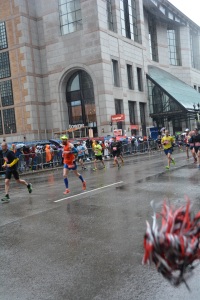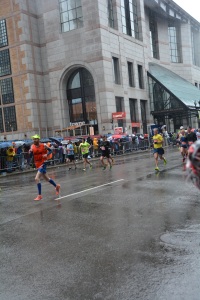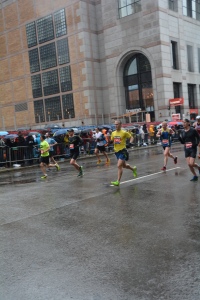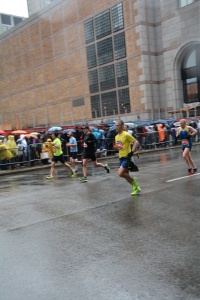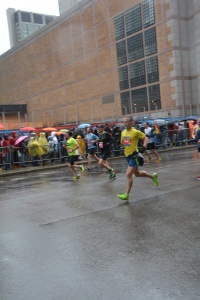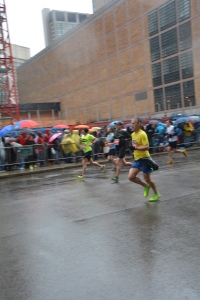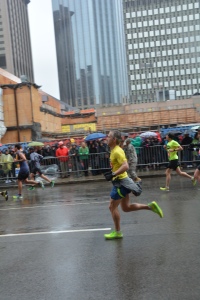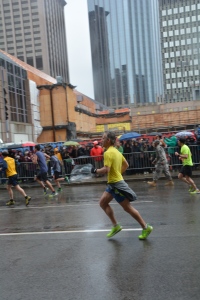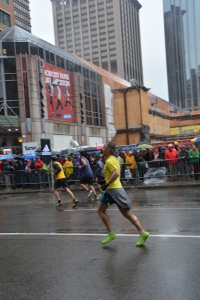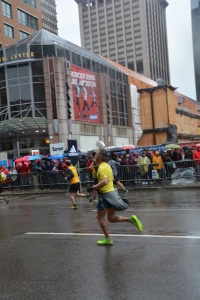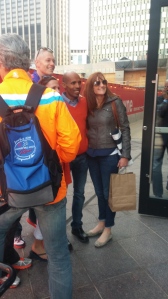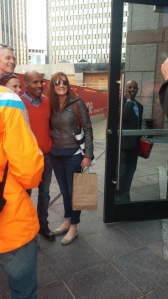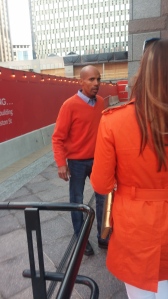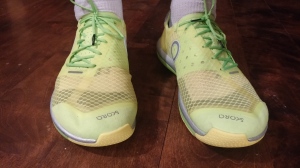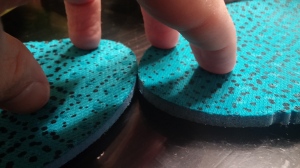This year I shaved five minutes off last year’s Boston Marathon debut. Three reasons. Number one: preparation. Number two: weather conditions. Number three: course familiarity.
The race went better than I could have possibly imagined beforehand. The results have me looking forward optimistically to the Hospital Hill Run (our big Half Marathon here in town) and a fall marathon (or two…). The bogeys: sub 1:30 and sub 3:00.
Writers note: this is my first blog post dictating using Dragon Naturally Speaking. Conclusions: it’s a lot harder to be concise when you are babbling into a recorder. It is a lot faster though! I mostly dictated this in my car over lunch while running an errand. On the other hand, I really like to talk about Boston, so perhaps that’s part of the problem.
The first of these, preparation. I put good effort into my training over the winter and it paid off. Coach Kyle meted out a training plan that was both challenging and attainable. The past four months included a mix of long runs, tempo runs, and recovery runs, with strength training sprinkled in (body weight stuff). It’s especially motivational to nail a key workout, and it’s fairly easy to identify them. When you find yourself doing 1 mile repeats in the mid 6s, you know that’s probably a key workout! You know good things are in store when you’re hitting your target paces, which are calculated to be within your capabilities but still provide a challenge. Also, winter training can be very difficult but the weather was not quite as bad as it was last year. I found myself running inside several times in February when I was trying to avoid some ice and snow on the sidewalks as well as some cold rain. I recall one Saturday when I was trying to get in a long run and it seemed like there was no way I was going to get the miles in. It was cold and raining, I’m pretty sure it was in the 30s. I think I kept hoping it would end before I finally gave up and headed to the community center for a combination of the treadmill and their indoor track. However, I had failed to notice that they closed fairly early (5 PM) and about an hour into my three hour run, I found that out. So, I went next to the “Great” Mall of the Great Plains. I tried to run laps indoors in this nearly-deserted mall. I got about 45 minutes in, but then a very nice older security guard came up to me and told me that I couldn’t run in there. If I was the property manager I wouldn’t have let me run in there either, but it was worth a try. I felt like I needed a “Skateboarding is not a crime” T-shirt! The mall was a mess, the roof was leaking in several places with buckets sitting on the floor and just flat out wet spots on the carpet. Not a week after I was there, a press release announced that the mall would be closing for good in the coming months. Suffice it to say, that was not very surprising to me, At any rate, I headed home and tried to finish up on our treadmill, which doesn’t like me (it works for my wife, but I am considerably heavier). The belt started slipping right away so I gave up, put on my rain gear, and headed outside for the last hour+. Mission accomplished!
Second reason: weather conditions. Coming into race day, weather forecast did not look very good and that turned out to be the case. When John and I got on the buses a little before 7am it wasn’t raining yet.
https://twitter.com/minimallyshoddy/status/590084436387061760
However, the first downpour of the day started soon after we got inside the tents at the athletes’ village. Fortunately there was room for everybody to get inside. Eventually, the rain from this first band of showers ended and we exited the tent and lined up in the corrals. The beginning of the race was dry and the rain held off for the first 6 miles or so. However, after that it started up again and eventually it rained hard enough to totally soak my clothing. I was dressed in tech shorts, tech T-shirt, wool Icebreaker socks, wool Icebreaker liner gloves, and Skora TEMPOs. For my review of the TEMPO click here.
I also slathered Alba Unpetroleum jelly all over my legs (and a few other places). Two benefits in the rain: warmth and chafing prevention. I brought a waterproof breathable shell tied around my waist to the starting line thinking I would have to put it on at some point. I had decided that my rule of thumb (pun intended) was going to be: once my hands got cold I would put it on. This shell can feel like putting on a sauna suit to drop weight for wrestling, or so I’m told, I was never a high school wrestler. So, I was trying to keep it off as long as possible. While of course I didn’t want to get hypothermia, I’d rather not be too hot either. So the rain came down and then eventually stopped again after a few miles and the wind picked up. A headwind is not ideal, but it did dry out my clothes, kind of, and we had a few dry miles. Later, it started raining again and the last third of the race was in a pretty steadily increasing rain. Temperatures started in the 40s and I doubt if they ever exceeded the 50 degree mark during the race. I never did put the jacket on because my hands never got cold. Unfortunately scores of others were not so lucky. On the way home, the RHSW and I ran into a lady who had to seek medical attention for hypothermia at about the 20 mile mark. She was so disappointed because the paramedics would not let her continue and ultimately she had to go to the hospital. When most people hear “rain!” they automatically assume that that’s a negative for racing. I’d say that the rain and the head wind were definitely not positives, but the cool temperatures were. Given the choice between: (1) last year, when temperatures rose into the upper 60s by the end of the race, with enough sun to give me a pretty decent sunburn; and (2) this year, with temperatures in the 40s, rain for most of the race, and a pretty strong headwind, I’ll still take this year any day. It was a thin line between hypothermia and being just barely warm enough. As I crossed the finish line, I slowed to a walk and was shivering and my teeth were chattering in less than a minute. I kept moving, putting on my waterproof breathable jacket while walking. Finally I got to the space blankets, which helped. I moved as quickly as I could to the gear check tents and the brisk walk warmed me up a little bit. Nevertheless I didn’t waste any time lingering and headed back to my hotel for a nice hot shower soon as I met up with the RHSW.
Third reason: course familiarity. There’s really no substitute for having run a course before. When I’m going to race a course and really want to do well on it, especially locally, I have always taken advantage of the ability to do some training runs on the course. I’ve done this for the Kansas City Marathon, for Hospital Hill, for the Heart of America Marathon, and even for some shorter runs. Personal experience with the elevation changes and apexes is invaluable. Last year, I had never run Boston before. I did have a highly detailed book that a friend had given me, including pictures and descriptions of the entire course. It was extremely helpful, but again, not a substitute. Of course your brain can process far more information when you’re experiencing something than when you’re just reading about it. I could tell the difference that familiarity made from one year to the next as I ran. I had a pretty good recall of what was coming up next. This helped immensely, because not only could I plan for upcoming difficult sections and take advantage of easy sections, I was also constantly comparing and evaluating whether or not I could improve in a section from last year. There were places where I was holding off last year because I didn’t know what was coming up next, but when you know you’re coming to the end of a tough stretch you can push through those last few seconds or minutes. While I was able to push harder on so many sections of the course because of the lower temperatures, but the combination of course familiarity with better conditions helped me take advantage. Another thing that I thought was kind of a fun reminder of the course layout was a 3-D topographic model that they had at the RunBase on Boylston. I stopped in there the night before and the RHSW got a shot of it. It’s a really cool model…layers of plywood giving you a pretty good appreciation for how the hills on the course lay out.
A further word about equipment. I ran this race in the Skora TEMPO. I’ve been running all of my long runs this training cycle in the TEMPO to evaluate the shoe in consideration for this race. I’m glad I decided to go with it. The thing I like about using this shoe for the marathon distance is that its elevated stack height and increased cushioning give me the ability to shift between a couple different landing zones. I typically land forefoot/midfoot. I find myself landing more towards the midfoot or a whole foot landing pattern with this shoe. I can tell from the wear pattern. I have noticed in all of my eleven marathons that shifting to a heel landing for as little as a couple hundred yards up to half a mile at some point during the last few miles helps out work out some of the discomfort that develops during a race, for instance, calf cramping. However, probably due to the cool conditions, I didn’t experience any cramping during this race.
Nutritionally, I followed my go-to protocol of the Western Australian carb loading method. Read my post about that here. I consumed the carb loading “elixir” all day long on Sunday after doing the shakeout/priming run with Jeremy and Nathan, fellow Skora Ambassadors. Nathan did the protocol as well. We saw Desi Linden (nee Davila) as we were running West along the Charles River. She makes it look easy, and she had a great race the next day. In our defense, we were in the middle of our warm-up miles. After our warm-up, it was interesting to see how much faster Nathan and Jeremy are than me. Nathan has 10 years on me and Jeremy has five (I’m counting backwards by the way, they’re younger!). Nathan pulled into the lead and Jeremy was pretty far ahead of me as well. I actually forgot to look and see when we started the hard running, but I was able to discern when they picked up the pace for the last 30 second all-out sprint so I followed suit and sure enough they stopped, which helped me figure out when to stop. Following this, I had a small low residue breakfast of scrambled eggs and a couple pieces of bacon. I had a late lunch consisting solely of a burger with cheese (no bun). I also had some candy to break up the monotony of the carb loading drink. On race morning, I finished off the carb loading drink, met John for a breakfast and had three fried eggs and some coffee. While were while riding the bus to the athletes village, I consumed most of the EFS gel that I had brought with me, about 400 cal worth, by sipping it slowly. At the athletes’ village, I had some coffee, some Clif shot blocks (not bad – they seemed innocuous enough to break the nothing new on race day rule), and a Gatorade carb energy drink to top off the tank. While not directly relevant to racing nutrition, when in Boston, make sure you try the claimed “original” Boston Cream Pie at Parker’s in the Omni! I had some Saturday and Monday, so still just one gluten cheat day per week.
My pacing strategy was better this year too. While it wasn’t all that bad last year, I seem to finally be making the transition to a negative split strategy under Kyle’s tutelage. Last year, before I started working with Kyle, I managed to stay fairly consistent over the course of the race. If I recall, none of my splits had anything other than a seven in front of them. However, the first few miles were probably a little too fast, then the Newton Hills slowed my pace. I had a few slow miles in the last 5 miles coming into downtown that probably could’ve been faster if I had paced better before, and they were starting to creep up towards the eight minute mark. This year however, I was remarkably consistent. My strategy was to hold off to around the 7:25 mark for the first 5 miles and then start pushing up the pace to goal pace of 7:15 as soon as I got past that five-mile mark. I was successful at doing this, and while pretty much everyone is going to fall off in the Newton Hills, I ran really strong through the hills. Thanks to my course familiarity, I was really able to put the hammer down as I came to the top at Boston College knowing that everything was downhill from there. They have a giant inflatable gateway at the top of the Newton Hills on the right that let you know that you’re done. And you really are – at that point the course gets a lot easier, coming into downtown it’s pretty much downhill or flat. I ran almost exactly even splits – maybe a little faster in the first half, but less than a minute.
I think I may have enjoyed myself even more this year than I did last year. I just felt so great during the entire race. It was amazing how the crowds came out even with the rain coming down. I try to make a point of high-fiving the little kids who have their hands out especially in the early sections of the course where there are more of them. Having the crowd support really helps in later miles, and I found that whenever I felt my pace was starting to flag a little bit it really helped to head over to the side of the road and pick up a boost of adrenaline with a few high fives. I never felt like I hit the wall. At Boston, the wall should be coming somewhere in or just after the Newton hills, but there was no perceptible change for me in energy level. Perhaps that’s because of the adrenaline of almost being done coupled with the crowd support and the knowledge that it’s all downhill during those last few miles. I’ve never felt better after crossing the finish line. I actually felt so fresh after crossing the finish line that I felt like I could have run some more. I try to leave it all out there, and while I ran the last mile hard and especially Boylston, I still felt like there was something left in the tank. I have to admit that I didn’t suffer enough to find out if I had a PR in me on Monday. My result was my second fastest (3:11:25). Before the race I would have thought that impossible. Now I have to wonder if I had pushed a little harder, might it have been there? However, you just can’t know how your body is going to react on a cold day.
Boylston! The home stretch:
I guess it’s kind of hard to complain about someone who is willing to wave a pom-pon for hours at a time…
Closer…
Still closer…
Almost even with the RHSW:
Passing…
Last two:
I recovered really well afterwards as well. I think that’s because there was no dehydration thanks to the cool temperatures. I didn’t really have to do much more than take a swallow or two of Gatorade at maybe 10 aid stations or less. After the race and a shower, it really helps that the RHSW and I walked back down to Boylston to grab a snack before we met up with John and his family for dinner. It kept me from stiffening up. In fact, a lady who was hobbling after finishing the race even remarked how it was unfair that I was walking normally.
Running is also about the connections with people that you make over the years and this year’s Boston was special in that regard. I ran the race again with my good friend and neighbor, John. He had his immediate family and his extended family there to watch him race. This year we got to ride the bus to Hopkinton together. I also got to meet two fellow Skora Ambassadors, Jeremy and Nathan, and Brian, a Skora employee who coordinates the program at dinner Saturday night.
Ok, there was a lot of shoe talk, to the chagrin of the spouses. It was just great to meet these other guys who share my perspective on running footwear and training. We all run in Skora shoes, and we’re all coached by Kyle, so that probably explains why we all ran so well! Nathan obliterated his goal of 2:50 by accelerating through the second half of the course. Jeremy PR’d at just over the three hour mark. Congratulations to both of those guys!
Also, I’m not really sure if this counts as a connection, but I was an elite magnet. I ran into Meb trying to sneak in the side door at the expo (he was sneaking, not me). I instantly recognized him, as did a few others. He graciously took a group picture, and I shook his hand. I was so star struck I couldn’t even think of anything to say. I wish I’d had a chance to gather my thoughts!
Here’s a couple of me and the RHSW on the way back from the expo, in front of a really gnarly tree on Boston Common:
I’m awkwardly trying to a) not obscure the cool part of the tree; and b) make contact with the RHSW.
The final results:
participant
totals
| place (M/W) | 4469 |
| place (ag) | 816 |
| place (total) | 4931 |
| time total (net) | 03:11:25 |
| time total (gun) | 03:16:36 |
race state
| race state | finished |
| last split | Finish Net |
splits
| Split | time of day | time | diff | min/mile | miles/h |
|---|---|---|---|---|---|
| 5K | 10:27:58AM | 00:22:45 | 22:45 | 07:20 | 8.20 |
| 10K | 10:50:51AM | 00:45:38 | 22:53 | 07:22 | 8.15 |
| 15K | 11:13:20AM | 01:08:07 | 22:29 | 07:15 | 8.29 |
| 20K | 11:35:45AM | 01:30:33 | 22:26 | 07:14 | 8.31 |
| HALF | 11:40:39AM | 01:35:27 | 04:54 | 07:12 | 8.34 |
| 25K | 11:58:12AM | 01:52:59 | 17:32 | 07:14 | 8.30 |
| 30K | 12:21:07PM | 02:15:54 | 22:55 | 07:23 | 8.14 |
| 35K | 12:44:13PM | 02:39:00 | 23:06 | 07:26 | 8.07 |
| 40K | 01:06:45PM | 03:01:32 | 22:32 | 07:16 | 8.27 |
| Finish Net | 01:16:37PM | 03:11:25 | 09:53 | 07:15 | 8.29 |
I love Boston, its marathon, and its people. I’ve already qualified for 2016, and I’ll be back if at all possible!



